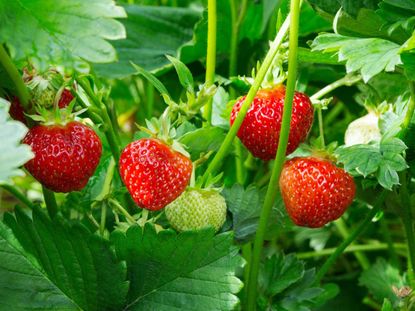When To Plant Strawberries: Growing Tips For Strawberry Plants

Strawberries are a delicious addition to any garden and provide a sweet treat all summer. In fact, one plant started in June can produce up to a hundred and twenty new plants in one season.
Growing strawberries is rewarding. Read on for specific tips on how to plant strawberries, when to plant strawberries, and strawberry plant care.
How and When to Plant Strawberries
When planning your strawberry patch, it’s important to know that strawberries thrive in full sun so locate a bright sunny spot where they’ll have six or more hours of full sun exposure.
Many varieties produce blossoms in early spring that can be killed by a late frost unless there’s plenty of sun on your plants. Most importantly, keep in mind that the amount of sun your plants get will determine the size of the crop and the size of the berries as well.
Rich soil with a pH factor of 6 to 6.5 works best for strawberries, so plan on working some organic compost into the soil in your beds or pots. The soil needs to be well-draining. Your plants should be spaced 1 to 1.5 feet (31-46 cm.) apart to allow plenty of room for them to grow and spread.
There are three basic types of strawberry plants: June-bearing, spring-bearing (which provides fruit early in the season), and everbearing (which will produce fruit all summer long). There are many varieties within these categories, so consult with your local garden nursery or extension service for the kinds that grow best in your area.
The best time to plant June and spring-bearing strawberries is on a cloudy day in March or April, as soon as the ground is workable. This gives the plants ample time to get established before warm weather arrives. Place them just deep enough into the soil to cover the roots with about 1/4 inch (6 mm.), leaving the crowns exposed.
Gardening tips, videos, info and more delivered right to your inbox!
Sign up for the Gardening Know How newsletter today and receive a free download of our most popular eBook "How to Grow Delicious Tomatoes."
Planting strawberries in rows requires about 3 to 4 feet (about 1 m.) between rows. This will allow June and spring-bearing plants enough space to send out “daughters,” or runners. If you have everbearing strawberry plants, you may want to plant them individually in mounded hills. These can be planted in mid-September to mid-October for a spring berry harvest.
Strawberry Plant Care
As soon as your plants are in the ground, water and apply an all-purpose fertilizer to get them off to a good start.
This is tough to do, but it’s important; remove all the blossoms from your June-bearing plant during its first growth season and remove blossoms from everbearing plants until early July. After these first rounds of blossoms are taken off, the plants will produce berries. Pinching the first blossoms helps the root systems strengthen and helps the plants make better, bigger berries.
Don’t drown your berry plants but try to be sure they are regularly watered with an average of 1 to 2 inches (2.5-5 cm.) of water every day. Drip or soaker hoses placed nearby work best.
Make sure your strawberries’ home doesn’t have perennial weeds and try not to plant them where tomatoes, potatoes, peppers, or even strawberries have been grown in the previous two years. This will help to avoid root disease problems.
Harvest your berries when they’re red and ripe and enjoy them in jams or desserts or freeze them to enjoy over the winter.
- Caroline BloomfieldManager of Marketing Communications
-
 Grow a Bathroom Oasis: 8 Best Bathroom Plants With No Light or Low Light
Grow a Bathroom Oasis: 8 Best Bathroom Plants With No Light or Low LightSome apartment dwellers grow the best bathroom plants with no light or low light. Read how one of our favorite plant lovers does it in the big city.
By Teo Spengler
-
 "My Worst Mistake" – Gardeners Share 10 Hard-Learned Lessons
"My Worst Mistake" – Gardeners Share 10 Hard-Learned LessonsGardeners never stop learning, and sometimes our mistakes are the best teachers. But why not save time and heartache by learning from other gardeners' failures?
By Melanie Griffiths